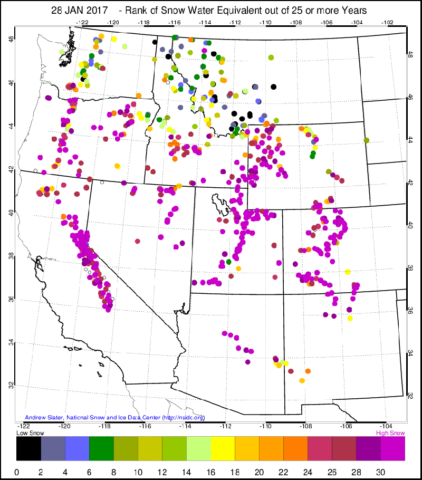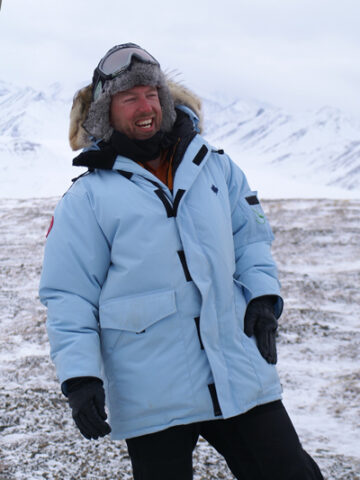
Drew was a force within the land modeling community. He transformed our capabilities to simulate terrestrial processes and change in cold regions. He was best known for his noteworthy advances in modeling snow, permafrost, and hydrologic processes in Arctic and mountain regions.
A complete scientist, Drew was a theorist, a modeler, an experimentalist, and a teacher, equally competent writing model code, analyzing satellite data, stomping through snow to collect measurements, and explaining to school kids the impact of climate change on skiing.
Drew pursued science and life with passion: He had keen insights and intellect; he sought innovative, meaningful, and thorough solutions to Earth science problems; and he was perpetually providing thoughtful critiques of ongoing work and engaging in fierce debates on ways to accelerate advances in land modeling capabilities.
Drew had a penchant for excellence: He thought that the research system was broken, and he strived to fix it. We wish to celebrate Drew’s scientific accomplishments and the enormous impact that he had on our field and our lives.
Early Snow Modeling Work
While Drew was in graduate school, he focused his attention on developing and evaluating snow parameterizations for use in climate models. In this work, he led the snow model intercomparisons in the Project for the Intercomparison of Land-Surface Parameterization Schemes (PILPS). This work was vital for the land modeling community to understand and address weaknesses in snow parameterizations.
Drew was able to identify specific reasons for wildly different model behavior.
In a paper he published on PILPS, he did not just document differences among models; critically, Drew was able to identify specific reasons for wildly different model behavior. Drew’s insights advanced understanding on how model representations of subgrid heterogeneity affect the amount of energy available for ablation and how intermodel differences in sensitivity to downward longwave radiation can be explained by stability-induced feedbacks. Many of us today still go back and reread Drew’s early PILPS paper to try and understand the behavior of modern land models.

After completing his Ph.D. in 2003, Drew focused a large part of his efforts toward advancing capabilities for streamflow forecasting in snowmelt-dominated river basins. Drew’s most noteworthy contribution in this area was his work on ensemble snow data assimilation. In Drew’s snow data assimilation paper he carefully characterized uncertainty in both model simulations and observations, and he demonstrated how advanced ensemble data assimilation methods could effectively constrain model simulations in the mountain ranges in the western United States.
Drew’s data assimilation work formed the basis for related work on assimilating satellite observations of snow-covered areas and streamflows in distributed hydrologic models. His work on mountain hydrology continued throughout the years.
Important recent papers include Drew’s critical evaluation of methods for snow reconstructions and his comprehensive compilation and analysis of solar radiation data from mesoscale observing networks. To make his research in mountain hydrology accessible to adventure seekers, Drew developed and maintained the popular West-wide real-time snow monitoring website, which is still active, to help outdoor enthusiasts select optimal locations for their winter sport activities.
Recent Work on Earth System Change
Drew published what was arguably the first study to provide a permafrost projection from a climate model.
The highlight of Drew’s career is his work to improve model parameterizations of land processes in the Arctic and to understand the degradation of permafrost in the 20th and 21st centuries. In 2005, Drew published analyses of permafrost simulations from a coupled climate model, arguably the first study to provide a permafrost projection from a climate model.
The results of this study projected substantial degradation of near-surface permafrost, heightening the concern that permafrost degradation could activate a large portion of the massive Arctic soil carbon pool and accelerate climate change. In this and subsequent papers, Drew exposed land model weaknesses, especially the need to increase the depth of the bottom boundary of the land model and explicitly represent soil organic matter.
Drew collaborated with the land modeling team at the National Center for Atmospheric Research for several years to address these weaknesses, and this work substantially improved the representation of cold region terrestrial processes in the Community Land Model. Drew’s 2013 paper on permafrost projections in climate models provides a robust picture of permafrost degradation in the 21st century. It shows that under a “business-as-usual” emissions scenario, permafrost is most likely to remain only in the Canadian Archipelago, Russian Arctic coast, and east Siberian uplands.
A Passion for Excellence, a Sense of Humor

In remembering Drew, we, of course, respect his scientific papers, yet more profoundly, we appreciate Drew’s passion for excellence and his good humor. Drew was vociferously critical of both mediocrity and showmanship. He would always call it as he saw it, no matter what the consequences would be for his professional development. Drew’s public critiques (and the fireworks that accompanied them!) were almost always well founded and well thought through, and they helped many in the community to lift their game. He was an excellent mentor for younger scientists, taking the time to teach effective research methods and programming practices.
For those of us who had the good fortune to work with Drew, we will always remember his incredible sense of humor, his infectious laugh, and his remarkable ability to develop meaningful personal relationships with most of his colleagues. We have all benefited from Drew’s participation in our projects, in part from his insights and in part because he just made the work more fun.
Drew Slater, land modeler extraordinaire: We miss you.
—Martyn P. Clark (email: [email protected]) and David Lawrence, National Center for Atmospheric Research, Boulder, Colo.; and Andrew P. Barrett, National Snow and Ice Data Center, Boulder, Colo.
Citation:
Clark, M. P., D. Lawrence, and A. P. Barrett (2017), Andrew G. Slater (1971–2016), Eos, 98, https://doi.org/10.1029/2017EO067429. Published on 08 February 2017.
Text © 2017. The authors. CC BY 3.0
Except where otherwise noted, images are subject to copyright. Any reuse without express permission from the copyright owner is prohibited.
